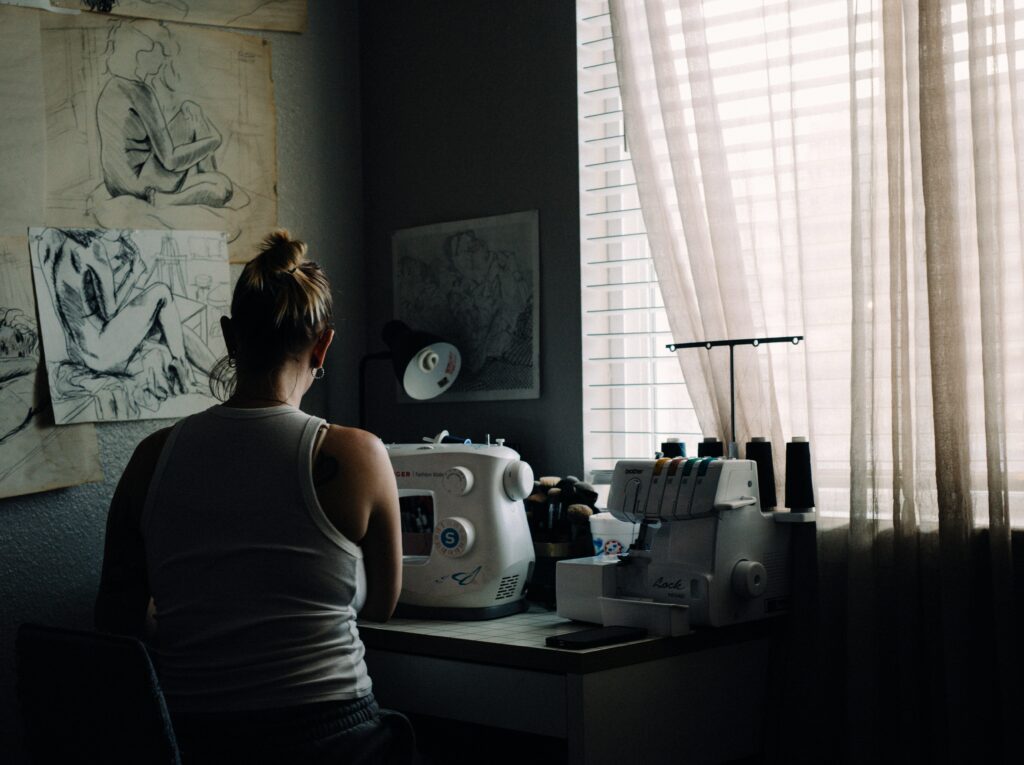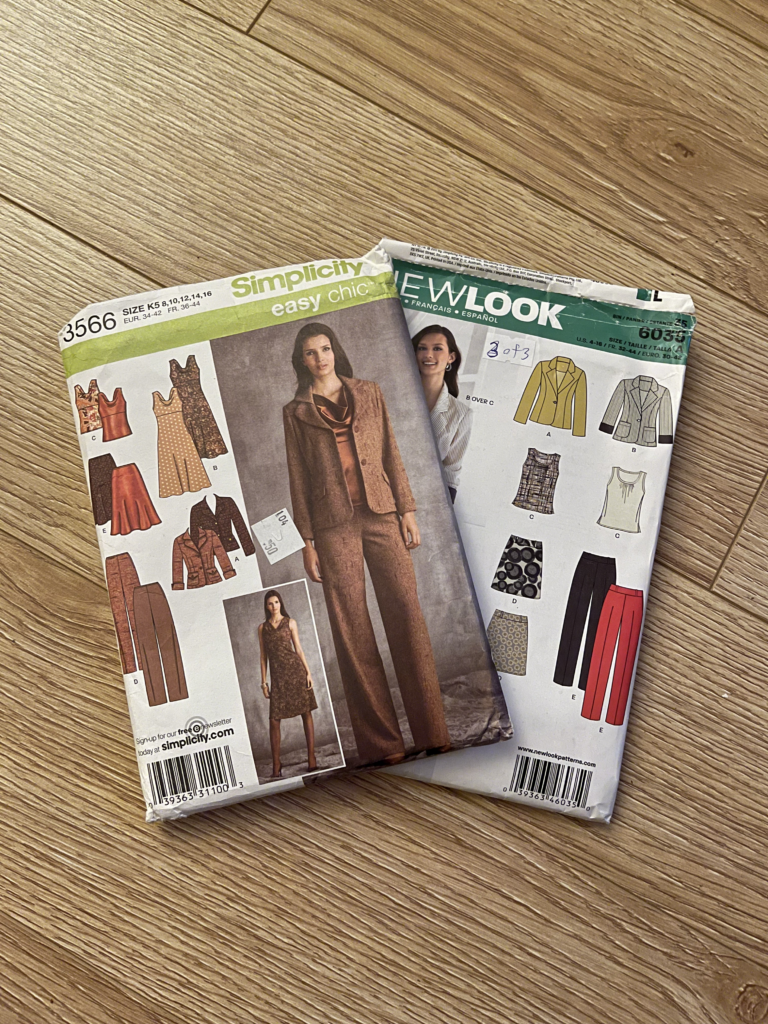(Budget Sewing to Take Control of Your Clothes)
By Paige McKay
Published December 13, 2024
Photo: Woman sitting at a sewing desk.
Parker Coffman on Unsplash

All clothing is handmade. Well, all clothing that involves stitching or sewing–so virtually everything–is constructed by a human person, regardless of the garment’s price point. Yet, the fashion industry remains a significant contributor to the global environmental crisis and a proven perpetrator of unethical labor practices. One large sector of the fashion industry is at the center of these controversies; ‘Fast Fashion’ is a rapidly growing fashion phenomena whose business model relies on the cheap and speedy production of low quality clothing, which gets pumped quickly through stores in order to meet the latest and newest trends. The cornerstone of fast fashion is today’s ever changing ‘micro-trend’ cycle, which compels consumers to continuously purchase cheap clothing and discard them quickly due to poor quality. In recent history, fashion functioned on the 20 year trend cycle, where aesthetics resurfaced about every 20 years. Consumers wore styles reminiscent of the 60s in the 80s, of the 70s in the 90, and so on. The advent of the internet and widespread media saturation has caused consumers to crave increasingly fast changing aesthetic styles in their clothing. Because of this new trend-chasing culture, clothing sales have doubled from 100 to 200 billion units a year since 2000, while the average number of times an item was worn has decreased by 36% overall. Fast fashion’s reliance on low-cost materials and high-speed production exacerbates its environmental impact and pressures consumers to discard poorly made clothing almost as quickly as they buy it.
The labor impact of the fast fashion industry is equally staggering. Reports suggest that one in six people globally work in some part of the fashion production industry, making fashion the most labour dependent industry in the world. Of the over 75 million factory workers in the fashion sector, less than 2 percent earn a living wage. In an effort for companies to minimize legal liability for their labor practices and cut costs, many brands choose to operate subsidiary factories in countries such as Vietnam, India, and Bangladesh. However, recent events like the 2019 garment workers strike in Bangladesh, and the Rana Plaza disaster in 2013, which killed well over 1,000 people, have drawn the public eye to the exploitative labor practices of big brands, who are now being called on to change the way they operate. In an effort to produce more clothing faster, and for cheaper, major brands take advantage of the lax labor, worker’s rights, and factory safety regulations of developing countries, resulting in countless deaths yearly.
Beyond exploitative labor practices, fast fashion is a major contributor to the ongoing environmental crisis. In fact, the production of fashion garments accounts for an astounding 10 percent of total carbon emissions globally, more than all international flights and maritime shipping combined. Not only does the mass production of clothing generate carbon emissions, a 2017 report from the International Union for Conservation of Nature estimated that 35% of all microplastics in the ocean come from the laundering of synthetic textiles like polyester. Fast fashion brands use the cheapest fabrics available to them in order to sell the product for the lowest possible price, therefore these companies use synthetic fibres like polyester, nylon and acrylic, which take hundreds of years to biodegrade. To counter this waste caused by fast fashion, more sustainable fabrics that can be used in clothing include wild silk, organic cotton, linen, hemp and lyocell. While the scale of the environmental and ethical impacts of the fashion industry seem impossible to contend with as an individual, Patsy Perry, a senior fashion marketing lecturer at the University of Manchester, suggests that concerned consumers start with the idea, “Less if always more”. The proposed solution to this is “slow fashion”, or coined by Kate Fletcher in her 2007 article for The Ecologist. Fletcher explains that slow fashion, “is not the opposite of fast – there is no dualism – but a different approach in which designers, buyers, retailers, and consumers are more aware of the impacts of products on workers, communities, and ecosystems”.
As the negative impacts of the fashion industry hang heavy on the minds of socially-aware consumers, many activists, sewists, and creatives are speaking out against and proposing solutions to the unsustainable cycle of the mainstream fashion industry. One such atelier is the Berlin-based fashion brand HUMAN TOUCH, who use their signature technique, “paint-sewing”, to make visible the human labour that goes into the construction of all of our clothing. This unique technique involves covering a sewists hands in textile paint so that their touches while constructing a garment will become a permanent visible fixture of the garment itself. An installation from HUMAN TOUCH’s performance at Positions Art Fair from September 2024 begs viewers to consider the ethical implications of their clothing consumption choices:
Picture a sewing machine
a person sewing away all day
turning, folding, draping the fabric
guiding it through the machine
the fingerprints of this labor leave an invisible trail
present on all garments
echoing the industrial and domestic
and the human experience of making
envision the invisible
fingerprints of tailors, garment workers, machinists
covering every piece of clothing you wear
HUMAN TOUCH
HUMAN TOUCH’s call to action for consumers: Try to envision the invisible: the fingerprints of tailors, garment workers, machinists covering every piece of clothing you wear. Today, countless people have made the decision to answer this call and alter their consumer practices to better reflect their environmental and ethical priorities. The proposed solution? Home sewing.
My first sewing project ever, at the age of 8, was in this very spirit. I entered a “recycled fashion competition” at my tiny Northern BC elementary school with absolutely no interest in environmentalism or sewing. As a rural, small town kid, I grew up living vicariously through the women I watched on TV in the Miss Universe Pageant and the Victoria’s Secret Fashion Show and I wanted nothing more than the opportunity to strut my stuff on the makeshift catwalk in the school gym. After asking my Nana for help making something for the fashion show, she showed me to her collection of discarded fabrics and scraps. Together, we used her old 1970s Kenmore sewing machine to put together my outfit for the fashion show. I proudly strutted down the catwalk in a bright orange ball gown, belted and trimmed with various mismatching black and gold ribbons. Unfortunately, I lost the competition to a little boy in a robot costume made out of recycled boxes and repurposed air vent hoses, but I continued learning to sew from my Nana. After sewing small crafts throughout elementary in middle school, I eventually took 3 years of formal sewing lessons in high school which led me to find my niche in garment construction and tailoring. While I’d like to think that my sense of fashion has come a long way since that traffic-cone orange gown, my love for sewing garments out of sustainably sourced materials has only grown. The 2019 COVID-19 lockdown actually gave me a lot of time to practice my sewing skills and by the summer of 2020 I had a quite elaborate sewing set-up and collection of completed projects. However, my ability to sew changed entirely in the fall of 2020 when I moved from my parents’ spacious home to a small rented room in a student house in Victoria to attend UVic.
After five years of sewing at university, I have found a way to adapt my approach to home sewing that allows me to continue constructing my own garments. In comparison to stereotypical home sewists, older adult women who have access to larger work spaces, investment quality sewing equipment, and their own homes, students face the unique challenge of having small living spaces, limited funds, noise restrictions, and sewing content that is not geared towards young people. The case for home sewing is not only supported by its slow fashion benefits, a 2018 study published in the Journal of Consumer Culture found that control over the consumption process, increased self-sufficiency, decreased environmental impact, and finding a sense of purpose in an impersonal high-tech society were sewists’ primary reasons for pursuing sewing their own clothing. According to a landmark study by Mys Tyler Insights, the majority (51.2%) of Canadian women are considered plus-size, wearing a size US14 or above. This data confirms that over half of Canadian women continue to be overlooked and underrepresented in clothing size ranges, advertising, and runway shows, by most brands. Mys Tyler founder Sarah Neil states that, “Underrepresentation in the fashion industry not only has a negative impact on how women feel about their bodies, but it directly translates to an inefficient shopping experience, poor fit, and high return rates – negatively impacting profits, and environmental sustainability. We hope the industry sees this data and uses it as a call to action to help increase representation and size-inclusivity.” The Journal of Consumer Culture’s study found that the ability to sew their own clothes resulted in an increased level of independence over their self-presentation, specifically for young women. Participants in the study also reported that they did not fit ready-to-wear sizing, and relied on their sewing skills to create or alter clothing to suit their unique measurements.
Don’t be fooled by the laundry list of supplies that online sewing discourse may suggest you need to purchase to create a suitable sewing set-up. A sewing machine, pair of scissors, tailor’s tape, ruler, pins, a pencil, and the required fabric and notions are all you need to sew basic items. Sourcing a sewing machine is typically the biggest outset cost of creating a sewing set up, however there are easy to find a sewing machine for a low or even free price. As home sewing was an essential skill for women in the home until the 20th century, and continued to be a valuable skill set through the mid 20th century, it is likely that older members of your family may have a sewing machine laying dormant, ready to be used by you. Alternatively, consider your local library or tool lending program as they often carry sewing machines that you can take out for the price of a library card. A local example is the Victoria Tool Library, which offers sewing machine lending. Some universities, like the University of Sydney offer sewing spaces and equipment for student use as well. Ayesha Shaikh, the student behind this pioneering university program says that, “sewing can be used as a tool to combat environmental pollution as well as human rights issues and the cost-of-living crisis… [her] hope is that students will use this space as a catalyst for creativity, collaboration, and positive change. Together, we can reimagine fashion as a force for good”. If it is necessary for you to purchase a sewing machine, Facebook marketplace sellers typically offer good condition used sewing machines for a fraction of their retail price. Because of the limited space available in most dorms and student housing situations, it is best to stick with a portable, table-top machine, rather than a desk mounted machine. While the side and store-ability of portable sewing machines make them attractive for students, these machines tend to create more noise than their desk-mounted counterparts. If your university experience is anything like mine has been, your sewing machine will never be as loud as your roommates. But, if you are looking to minimize noise, try keeping your machine well oiled with sewing machine oil, sewing on a very stable surface like a kitchen counter or very sturdy desk, and sewing at lower speeds, so as not to cause the machine to rattle.
While many people have only been exposed to dated sewing patterns in highschool home economics class or their grandma’s sewing room, there are a wide variety of stylish contemporary patterns available for free or at a very low cost if you are willing to look. Second hand stores like Salvation Army, Value Village, and Hospital Auxiliary shops typically sell used sewing patterns for between 50 cents and 3 dollars. The advantage of purchasing commercially produced patterns is the ease of pattern accuracy and instructions. While these patterns often appear dated in style, many patterns include timeless staple designs that can be made up in a fabric to suit your taste. Consider, for example, this Simplicity 3566 pattern that I purchased second hand for 50 cents, while it retails for $23.61 on Etsy. Although this pattern was copyrighted in 2007, and the sample images definitely suggest an early 2000s fashion sensibility, the slinky cowl neck dress pattern offered in this set (View B) looks strikingly similar to the bias-cut cowl-neck dresses that have been on trend in 2024. Pattern house Seamwork suggests that a well fitting bias cut dress can be a wardrobe chameleon, giving a slight nod to romantic, vintage style. Made up in a light to medium-weight woven fabric such as lawn, linen blends, rayon challis, voile, crepe, viscose, Tencel, or charmeuse, this dated pattern could become a stylish staple of your wardrobe. Commercially produced patterns are also available online, if you are willing to cover the cost of having it printed. Websites like Mood Fabrics, Let Them Eat Silk, the thread, Initiative Handarbeit, Seamwork, The Fold Line, and Unfettered Patterns provide a wide range of free PDF patterns to suit all personal tastes. Low cost patterns can also be found on Etsy and are an opportunity to support small, independent pattern makers. PDF patterns can be printed for a low cost on regular, letter sized, paper at a print shop or library. Some specialty sewing stores also offer large scale pattern printing for a greater cost. In addition to being a low cost way to source the exact item of clothing you are looking for, sewing patterns also typically offer a larger range of sizing than ready to wear clothing in-store.

Paige McKay

Good Faces on Unsplash
Sourcing fabric can become an expensive, wasteful, and space-consuming task, if you are not careful. When purchasing fabric on a small scale budget and storage situation, remember to always choose your project before choosing fabric for it. While you may be inclined to purchase fabrics because they are a good deal, or you are certain that you will use them for a later project, fabrics purchased without a determined purpose in mind almost always end up remaining unused, taking up unnecessary space. While it is possible to create garments out of repurposed bedding, table cloths, curtains, or blankets, these materials are often not suitable for long term wear or will not create the desired look once the project is completed, resulting in the garment not being worn. Deadstock fabrics offer an affordable and sustainable alternative to purchasing new fabric, but still offer the convenience and selection of fabric made for garment construction. Deadstock fabric is leftover fabric rolls from fashion designers and garment manufacturers. This fabric is often sold at specialty sewing stores for a discounted price, as it would otherwise go to waste. In Victoria, deadstock fabric is available at stores like Gala Fabrics and Win Win Textiles.
The fashion industry’s devastating ethical and ecological consequences demand urgent action from consumers and brands alike. By understanding the exploitative labor practices behind the clothing in your closet and acknowledging the environmental toll of fast fashion, we can begin to reshape our consumption habits. One proposed solution is home sewing, which allows consumers to create garments that reflect their unique style, fit their bodies perfectly, and reduce reliance on unethical and environmentally harmful practices. While students may have the impression that home sewing is only accessible to the older generation, I have learned from life experience that there is a way to enjoy garment creation even as a student. Whether by borrowing a sewing machine, sourcing sustainable fabrics, or repurposing existing materials, home sewing is accessible to anyone willing to take the first step. As consumers, we have the power to support slow fashion, prioritize quality over quantity, and embrace the artistry and creativity of handmade clothing. Frances Tobin founder of The Maker’s Atelier provides a poignant argument for pursuing home sewing when she explains that, “the immediate benefit of sewing your own clothing is the sense of achievement that comes with creating a garment, in a fabric of your choice, and the enjoyment of making. In the longer term, we have a different relationship with clothes we have made for ourselves. The garments have more intrinsic value and they are less disposable.”
Provide Feedback
You must be logged in to post a comment.